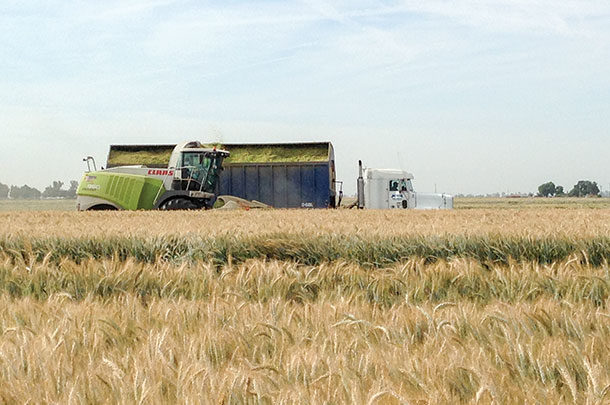It has proven to have higher protein content than both of its parents and can be fed out in the field as a green forage crop, chopped and used as silage or baled and fed dry; it can even be plowed under for a good manure crop. There are fall and spring varieties, as well as specific varieties that target all of those different uses.
According to the 2007 Census of Agriculture, 464 farms in over 30 states raised triticale. Total production that year was 2.5 million bushels with Washington, Texas, California and Kansas listed as the top producing states and the majority was used as forage and pasture.
But in the last decade, new champions of triticale are showing up all over the U.S. As it turns out, triticale is a very versatile crop, particularly where there are cattle needing good quality, inexpensive feed.
Ted Rogers is the business manager over triticale for Northern Seed Company out of Montana, and he says triticale is really making a name for itself as a double crop – the placeholder between cash crops that is becoming a very valuable crop on its own.
“Growers like it for its shorter harvest that opens up choices for a longer-day corn,” Rogers says. “They plant it during the fall, and it starts growing and then slows during winter. They let it grow in the spring to the flag leaf stage, then chop it and put it in the silo and then they plant their corn.”
Sam Brandenburg runs Brandenburg Hay and Cattle in east-central Illinois, and he uses his triticale as a double crop opposite his seed beans but says it has earned its place in his rotation.
“I plant it in the fall and then chop it, wrap it and bale it at the 55 to 60 percent moisture range. It’s heavy, and it doesn’t pay to ship it, but I figure it is worth about 45 dollars a ton, and we were averaging 10 tons per acre last year. That’s $450 per acre for a crop that is a placeholder,” Brandenburg says. “With the tight farm margins the way they are, that’s another way to crank out an extra value per acre.”
Brandenburg says he is currently feeding triticale that has been in the bag almost a year, and it is showing no spoilage. He figures it would easily last 16 months if he needed it to. He mixes it with the last of his pearl millet and some straw in his feed ration and figures he is feeding his cattle a balanced ration for less than 30 cents a day.
“I like triticale because it matures later than rye,” he says. “I like to cut it at boot stage before it heads out, and it gives me a bigger window – so I can choose when to cut it and fit that in around other commitments. You get a lot of roughage in very little time.”
Steve Isaacson is another beef producer who grows triticale for his Sassafras River Beef in Maryland, but he also recommends it at his other job where he is a nutritionist for dairy feeds for Cargill, based in the mid-Atlantic region of Delaware, Maryland and Pennsylvania.
“I recommend feeding triticale to dairy cattle,” he says. “In our region, it is grown as part of a cover crop program along with barley and wheat. It gives us a higher yield that is very nutritionally balanced and very digestible.”
Isaacson says they have found grass and small-grain silage has a higher NDF (neutral detergent fiber) than alfalfa, and he has been noticing more of the growers in his area leaving alfalfa to grow and feed triticale.
“It produces great tonnage,” Isaacson says. “It is a great feed to cut and use as silage.”
According to Rogers, some growers use it for both a forage crop and a silage crop the same year – allowing their cattle to graze it for a time and then chopping it at a later date. He says it has more forage yield than wheat and is cheaper to plant; it has better disease resistance, greater heat tolerance and growers end up spending less on sprays.
Many organic programs find triticale a good fit for their systems.
“Triticale is more economical,” Rogers says. “It was primarily bred as a grain crop with less forage, but there are also varieties that have been grown with great forage.”
Rogers says it doesn’t take any special modifications to harvest it – usually a grower has the implements on hand, plus he can choose when he will harvest based on what he wants to use it for.
“The taller grains put their energy into their seedheads; the forage grains put their energy into the leaves. You can grow it like a hay and then swath it, bale it and harvest it at soft dough stage,” he says. “It’s a versatile product. If you don’t double crop it, you can just leave it and it will last until you harvest it – whenever that is.”
Rogers says there is an ebb and flow to food production, and this year where there is a glut on the market of other small-grain commodities, it might be the perfect time to try something new like triticale. It seems that once producers grow it and discover how easy it is to harvest, they grow it again and usually plant more acreage than they had originally.
Joan Bucher of Bucher Cattle Company in Good Hope, Illinois, says she likes to plant her triticale in September and then graze cattle on it in December for a short period. She lets it grow again, will graze it one more time in the spring and then later will chop it and plant corn after it.
“It is higher protein and my cattle love to graze it, but they also love it chopped,” she says. “It’s a durable grass and a great cover crop. I planted more this year than I did last year.” ![]()
PHOTO: Ripened triticale is harvested in California. Photo provided by Ted Rogers.
Becky Cook is a freelance writer based in Idaho.













